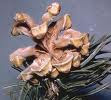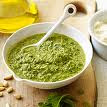 |
| oud resin |
OUD OIL FROM AQUILARIA SP. TREES
The tree from which oud comes is known by many names including: - Eagleswood, Aloeswood, Agarwood and Kiara. Its name is oud in Arabic and Urdu, but should not be confused with the stringed instrument rather like an old fashioned lute which has the same name. In Hindi it is known as agar, not to be confused with the seaweed used for a gel instead of gelatine, which we in the West call agar agar. Oud oil is the most expensive oil in the world, and has been for millennia. It is the aloeswood of the Bible, and is little known in the West. The markets for it continue to be in the Middle East, the Indian subcontinent and Japan where it is used in religious and cultural ceremonies as well as in traditional medicine.
The agarwood trees originate in Pakistan, India, Bhutan, Thailand, Cambodia, Vietnam and Indonesia including Papua New Guinea.
 |
| tree infected by fungus |
It is mentioned in the Sanskrit Veda texts and in the chronicle written in the 3rd century AD by Wa Zhen, “Nan zhou yi wu shi” (“Strange Things from the South”). It is found in the Far East and Asia and is the most luxurious perfume base that money can buy. It takes around 300 years to form, and trade routes for this and other perfumes and incense such as frankincense and myrrh were well-established by 1500 BC.
In the Middle East and the Indian subcontinent there is a legend which says that oud came from Paradise with Adam. He covered himself with the leaves from the agarwood to shield his nakedness and when he fell from paradise, the leaves were scattered by the wind and fell over Asia and Indian subcontinent where have grown ever since.
Ibn Sina or Avicenna as he is known in the West improved the distillation process for making Attar of roses and this helped the production of oud oil too. Today oud oil costs more than $27,000 a pound weight, and the agarwood for making incense or incense burners costs $13,000 a kilo for top quality wood. An ounce of standard quality oud oil goes for somewhere around $1000-$1400 US. A miniscule amount of the oil will release its fragrance for 8 hours.
 The oil is reminiscent of amber oil and in her book, “The Complete Incense Book”, Susanne Fischer-Rice describes the perfume in this way: “Agarwood has balsamic ambergris, woody, deep fragrance. To experience the many nuances of this unique substance is like a journey on the road to spiritual perfection”. So it will come as no surprise to you that it is used by Buddhists to prepare for meditation. The oil and incense produced from the wood has also been used as an aphrodisiac for centuries.
The oil is reminiscent of amber oil and in her book, “The Complete Incense Book”, Susanne Fischer-Rice describes the perfume in this way: “Agarwood has balsamic ambergris, woody, deep fragrance. To experience the many nuances of this unique substance is like a journey on the road to spiritual perfection”. So it will come as no surprise to you that it is used by Buddhists to prepare for meditation. The oil and incense produced from the wood has also been used as an aphrodisiac for centuries. Unfortunately, naturally enough the agarwood tree is endangered because of the value of the oil. Poachers deplete the stocks of agarwood trees and they are listed in the Convention on International Trade in Endangered Species of Wild Fauna and Flora CITES). The Aquilaria malaccensis was put on the list in 1995 and all the other species of Aquilaria were added in 2004.
 |
| germinating saplings |
In India, Pakistan and Thailand the agarwood trees still exist in the wild, but they are in inaccessible forests which are dangerous for poachers and traders alike. Growing the trees in plantations and using sustainable methods to extract the oil will help the wild trees’ survival, and hopefully they will not go the way of the long extinct Pinus succinifera from which we get amber.
Oud oil is used in traditional medicine for a number of purposes, including to help in childbirth. Breathing the smoke from the burning wood will help with respiratory problems, colds, coughs and asthma. The oil has been used to help sufferers of rheumatism, as a stimulant and a tonic combined with other ingredients. It helps lift the spirit and boosts energy levels. However it is so expensive that the price prohibits the treatments. It is used in mosques, sometimes they have the wood as a burner for other incense, and sometimes they burn the wood chips as incense, along with amber and frankincense.



















